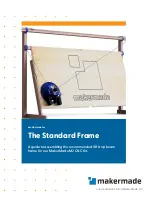
-20-
Aluminum Oxide Grinding Stones
(red/brown)
Round, pointed, flat — you name the shape
and there is one available in this category.
These are made of aluminum oxide and cover
virtually every possible kind of grinding
application. Use them for sharpening lawn
mower blades, screwdriver tips, knives,
scissors, chisels and other cutting tools. Use to
remove flash from metal castings, deburring
any metal after cutting, smoothing welded
joints, grinding off rivets and removing rust.
These grinding stones can be resharped with a
dressing stone. In machine shops, high speed
drills and cutters normally are ground with
aluminum oxide wheels. 1/8" shank.
Silicon Carbide Grinding Stones
(blue/green)
Tougher than aluminum oxide points, these
are made especially for use on hard materials
such as glass and ceramics. Typical uses
might be the removal of stilt marks and excess
glaze on ceramics and engraving on glass.
1/8" shank.
Diamond Wheel Points
Excellent for fine detail work on wood, jade,
ceramic, glass and other hard material. Bits
are covered with diamond particles. 3/32"
shanks. (Not recommended for drilling)
Wire Brushes
Three different shapes of wire brushes are
available.
For best results wire brushes
should be used at speeds not greater than
15,000 RPM. Refer to Operating Speeds
section for proper tool speed setting.
The
three shapes come in three different materials:
stainless steel, brass and carbon wire. The
stainless steel perform well on pewter,
aluminum, stainless steel, and other metals,
without leaving "after-rust". Brass brushes are
non sparking, and softer than steel; making
them good for use on soft metal like gold,
cooper and brass. The carbon wire brushes
are good for general purpose cleaning.
Bristle Brushes
These are excellent cleaning tools on
silverware, jewelry and antiques. The three
shapes make it possible to get into tight
corners and other difficult places. Bristle
brushes can be used with polishing compound
for faster cleaning or polishing.
Brushing Pressure
1. Remember, the tips of a wire brush do the
work. Operate the brush with the lightest
pressure so only the tips of the wire come in
contact with the work.
2. If heavier pressures are used, the wires will
be overstressed, resulting in a wiping action;
and if this is continued, the life of the brush will
be shortened due to wire fatigue.
3. Apply the brush to the work in such a way
that as much of the brush face as possible is in
full contact with the work. Applying the side or
edge of the brush to the work will result in wire
breakage and shortened brush life.
Dremel Accessories (Cont.)
CORRECT:
Wire tips doing the work.
INCORRECT:
Excessive pressure can cause wire breakage.
BM 2610951850 08-07 8/15/07 3:50 PM Page 20
















































